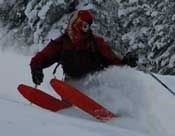
Uploaded with ImageShack.us[/img]
hi,
in burton's website there are pictures of the cores they use in their boards.
the "dragonfly" core (seen above) has parts -around the heel and toe area, where the wood is placed with the grain crosswise, 90 deg to the length of the board.
last year i tried the 158 "Cudtom X" that uses this core concept, and i was really pleased with the board's flex pattern (great edge-hold, solid, very precice feel when loading the edge).
im thinking to try a similar lamination, propably with not that many parts, a simpler version of burtons core.
i press with vacumn, cure temp ~55 oC, and i deal with the small (10-20%) springback i get by over camber the mold.
so, my concern about using this core is a posiible uneven spring back due to the diferrent grain orientention, that will result in a concave base.
maybe a fat hard wood sidewall would smooth things up, but still i am concern about possible deformations
any opinion would be very welcome,
thanks, faidros
(sorry for my bad english, its not my native language)
http://img40.imageshack.us/img40/4063/b ... e00091.jpg




